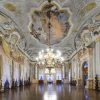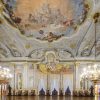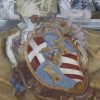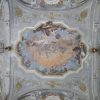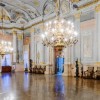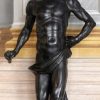70 years after Longhena’s death, Giorgio Massari created two new areas over the old ones, which added to the spectacular effect of his predecessor’s project: the staircase and a large ballroom. The latter monumental room, made by demolishing the ceiling and thus exploiting the whole height of the two main floors, was unrivalled in Venice as regards both its size and the quality of its painted decorations.
It was 1751. Since Tiepolo was away in Germany working for the bishop prince of Wurzburg, the painting of the frescoes was commissioned from a highly original artist, Giambattista Crosato, fresh from his successes as Savoy court painter in Turin. As recent studies have revealed, Girolamo Mengozzi Colonna, Giambattista Tiepolo’s great quadratura or architectural trompe-l’oeil painter, who had remained in Venice after his friend’s departure, collaborated with Crosato. Mengozzi Colonna created here an highly effective illusionist space.
Stretching behind a front order of gigantic pilaster strips with gilded capitals alternating with fake statues, is a perimeter of grey marble columns. These support an architrave in red Verona stone, faking the module of the actual front doorway. In the upper part the artist has expanded the space, suggesting a flight of rooms beyond the loggias and the balconies painted at the sides.
In the middle of the ceiling, Giambattista Crosato has shown Apollo the sun god, rising with his chariot to radiate the four parts of the world, which are personified here by girls of different races. This subject was frequent in patrician residences because it was considered auspicious, alluding to the radiant future awaiting the palace owner. And it is the Rezzonico family itself which welcomes us into the ballroom, with their grandiose gigantic coat-of-arms on the wall in front of the door.
The room is a heraldic and allegorical exaltation of the owners; the two-headed eagles of their coat-of-arms is repeated on all the column capitals. Rarely however has painting celebrated itself and its illusionist potential as it does here. The visitor is transported into a magical, fairytale atmosphere within the walls of a family home.
The only pieces of the original furnishings remaining are the two majestic wooden chandeliers with floral patterns in gilded metal. Along the walls we find lavish ornamental furnishings in ebony and boxwood by Andrea Brustolon, one of the greatest Baroque sculptors of wood, christened by Honoré de Balzac “le Michel Ange du bois”.
There are 40 or so pieces, some of which are displayed in the room specifically dedicated to Brustolon. The series was originally created for palazzo Venier at San Vio, and includes chairs, vase-bearing statues and ornamental figures of Ethiopian slaves and warriors. The sculptor’s imagination has transformed the various elements of the furnishings into an opulent triumph of intertwined branches and actual fullyformed sculptures. The frames of the 12 monumental chairs are in the same materials. Not one of these chairs is the same as any other. Here Brustolon’s imagination had a field day, inventing different legs and armrests which reproduced tree branches supported by telamons, and with little fauns and exotic cupids peeping through them. It is probably the most sumptuous group of Venetian furnishings which has come down to us, and it reveals the exuberant decorative taste of Venetian Baroque.
